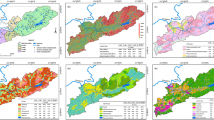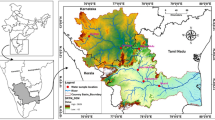Abstract
CO2 consumption by silicate weathering has exerted a major control on atmospheric CO2 over geologic time. In order to assess plant impact on this process, the study compared water geochemistry and CO2 consumption rates by silicate weathering in watersheds covered by bamboos and other forests. Our study showed that SiO2 concentrations (80 ~ 150 μmol/L, average 105 μmol/L) in water from pure bamboo forest watersheds were higher than that (15 ~ 85 μmol/L, average 60 μmol/L) from other watersheds. Si/(Nasilicate + Ksilicate) ratios in water draining from bamboo watersheds (2.0 ~ 4.0, average 2.9) were higher than that from other watersheds ?>(0.7 ~ 2.7, average 2.2). CO2 consumption rates by silicate weathering in bamboo watersheds (1.8 ~ 3.4 105 mol/km2/yr, average 2.5 105 mol/km2/yr) were higher than that in other watersheds (1.5 ~ 2.6 105 mol/km2/yr, average 2.0 105 mol/km2/yr). Therefore, bamboo-enhanced silicate weathering is a potential biogeochemical remediation approach for atmospheric CO2.



Similar content being viewed by others
Literature Cited
Alexandre, A., J. D. Meunier, F. Colin & J. M. Koud. 1997. Plant impact on the biogeochemical cycle of silicon and related weathering processes. Geochimica et Cosmochimica Acta 61(3): 677–682.
Berner, R. A., A. C. Lasaga & R. M. Garrels. 1983. The carbonate silicate geochemical cycle and its effect on atmospheric carbon dioxide over the past 100 million years. American Journal of Science 283: 641–683.
——— 1992. Weathering, plants, and the long-term carbon cycle. Geochimica et Cosmochimica Acta 56: 3225–3231.
Bystriakova, N., V. Kapos, I. Lysenko & C. M. A. Stapleton. 2003. Distribution and conservation status of forest bamboo biodiversity in the Asia-Pacific Region. Biodiversity and Conservation 12: 1833–1841.
Christanty, L., J. P. Kimmins & D. Mailly. 1997. ‘Without bamboo, the land dies’: a conceptual model of the biogeochemical role of bamboo in an Indonesian agroforestry system. Forest Ecology and Management 91: 83–91.
Derry, L. A., A. C. Kurtz, K. Ziegler & O. A. Chadwick. 2005. Biological control of terrestrial silica cycling and export fluxes to watersheds. Nature 433(7027): 728–731.
Ding, T. P., J. X. Zhou, D. F. Wan, Z. Y. Chen, C. Y. Wang & F. Zhang. 2008. Silicon isotope fractionation in bamboo and its significance to the biogeochemical cycle of silicon. Geochimica et Cosmochimica Acta 72: 1381–1395.
Han, G. & C. Q. Liu. 2004. Water geochemistry controlled by carbonate dissolution: a study of the river waters draining karst-dominated terrain, Guizhou Province, China. Chemical Geology 204: 1–21.
Hinsinger, P., O. N. Fernandes Barros & M. F. Benedetti. 2001. Plant-induced weathering of a basaltic rock: experimental evidence. Geochimica et Cosmochimica Acta 65(1): 137–152.
Johnson-Maynard, J. L., R. C. Graham, P. J. Shouse & S. A. Quideau. 2005. Base cation and silicon biogeochemistry under pine and scrub oak monocultures: implications for weathering rates. Geoderma 126: 353–365.
Kelly, E. F., O. A. Chadwick & T. E. Hilinski. 1998. The effect of plants on mineral weathering. Biogeochemistry 42: 21–53.
Kurtz, A. C., L. A. Derry & O. A. Chadwick. 2002. Germanium–silicon fractionation in the weathering environment. Geochimica et Cosmochimica Acta 66(9): 1525–1537.
Li, Z., P. Lin, J. He, Z. Yang & Y. Lin. 2006. Silicon’s organic pool and biological cycle in moso bamboo community of Wuyishan Biosphere Reserve. Journal of Zhejiang University SCIENCE B 7(11): 849–857.
Mailly, D., L. Christanty & J. P. Kimmins. 1997. ‘Without bamboo, the land dies’: nutrient cycling and biogeochemistry of a Javanese bamboo talun-kebun system. Forest Ecology and Management 91(2–3): 155–173.
Moulton, K. L., J. West & R. A. Berner. 2000. Solute flux and mineral mass balance approaches to the quantification of plant effects on silicate weathering. American Journal of Science 300: 539–570.
Acknowledgements
We are grateful for support from Zhejiang Provincial Natural Science Foundation Program (Grant No. Y5080110 and Z5080203); Opening Project of State Key Laboratory of Environmental Geochemistry (SKLEG9011); Research Development Program of Zhejiang A & F University (2351000741 and 2451012029).
Author information
Authors and Affiliations
Corresponding author
Rights and permissions
About this article
Cite this article
Song, Z., Zhao, S., Zhang, Y. et al. Plant Impact on CO2 Consumption by Silicate Weathering: The Role of Bamboo. Bot. Rev. 77, 208–213 (2011). https://doi.org/10.1007/s12229-011-9077-9
Published:
Issue Date:
DOI: https://doi.org/10.1007/s12229-011-9077-9




